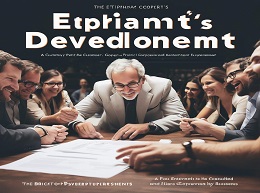Reinventing Organizations: A Guide to Creating Organizations Inspired by the Next Stage of Human

Reinventing Organizations: A Blueprint for the Future of Work - A Comprehensive Review
"Reinventing Organizations: A Guide to Creating Organizations Inspired by the Next Stage of Human Consciousness" by Frederic Laloux is a groundbreaking book that challenges traditional management practices and offers a visionary blueprint for the future of work. By exploring how innovative organizations operate at higher levels of consciousness, Laloux provides a roadmap for creating more fulfilling, efficient, and adaptive workplaces. This review delves into the book's key concepts, illustrates them with engaging examples, and discusses the broader implications for modern organizations.
A New Paradigm for Organizational Development
Laloux's "Reinventing Organizations" introduces the concept of evolutionary organizations entities that transcend traditional hierarchical models to embrace a more holistic, human-centric approach. These organizations operate on what Laloux terms the "Teal" level of consciousness, characterized by self-management, wholeness, and evolutionary purpose.
The Evolution of Organizational Paradigms
Laloux traces the historical evolution of organizational models, categorizing them by color to signify different stages of development:
1. Red Organizations : Command and control structures driven by fear and power.
2. Amber Organizations : Highly structured, with clear hierarchies and stability.
3. Orange Organizations : Achievement-oriented, focusing on innovation and competition.
4. Green Organizations : Emphasize empowerment, values, and stakeholder happiness.
5. Teal Organizations : Operate with self-management, wholeness, and evolutionary purpose.
Self-Management
Teal organizations eschew traditional hierarchies in favor of self-managing teams. These teams operate autonomously, making decisions collectively and holding themselves accountable.
Example: Buurtzorg
Buurtzorg, a Dutch home care organization, is a prime example of a Teal organization. Nurses work in self-managed teams, without traditional managers, and are responsible for everything from patient care to administrative tasks. This model has led to higher employee satisfaction, better patient outcomes, and significant cost savings.
Wholeness
Wholeness in Teal organizations refers to creating environments where employees can bring their whole selves to work, fostering authenticity, and emotional connection.
Example: Patagonia
Patagonia, the outdoor apparel company, encourages employees to express their values and passions at work. The company offers flexible schedules, supports activism, and fosters a culture of inclusivity and purpose. This approach not only enhances employee well-being but also drives innovation and customer loyalty.
Evolutionary Purpose
Teal organizations are guided by a sense of purpose that evolves organically rather than being dictated from the top. This purpose is aligned with the collective aspirations of the organization and its stakeholders.
Example: Holacracy at Zappos
Zappos, an online shoe and clothing retailer, adopted Holacracy, a system of self-management that aligns with Teal principles. This approach allows the company's purpose to evolve naturally through the contributions and insights of all employees, fostering a dynamic and adaptive organizational culture.
Practical Implementation of Teal Principles
Laloux provides practical guidance on how organizations can transition to Teal principles, including:
1. Fostering a Culture of Trust : Building trust is foundational to enabling self-management and wholeness. This involves transparent communication, shared values, and mutual respect.
2. Encouraging Self-Leadership : Employees should be empowered to take initiative, make decisions, and contribute to the organization's purpose without needing top-down directives.
3. Creating Safe Spaces for Dialogue : Open, honest communication is crucial for fostering wholeness and aligning with the organization's evolutionary purpose. Regular check-ins and feedback loops can help maintain this culture.
4. Embracing Iterative Change : Transitioning to Teal is an iterative process that requires continuous learning and adaptation. Organizations should be prepared to experiment, reflect, and adjust their practices as they evolve.
Overcoming Challenges in Transitioning to Teal
Transitioning to a Teal organization is not without challenges. Laloux identifies common obstacles and strategies to overcome them:
1. Resistance to Change : Traditional hierarchies can be deeply ingrained. Overcoming resistance requires clear communication, education, and involving employees in the change process.
2. Maintaining Cohesion : In the absence of traditional structures, maintaining cohesion and alignment can be challenging. Regular team-building activities and shared rituals can help foster a sense of community.
3. Balancing Autonomy and Accountability : While autonomy is a key principle, it must be balanced with accountability. Establishing clear roles, responsibilities, and performance metrics can help maintain this balance.
Buurtzorg: Revolutionizing Home Care
Buurtzorg has revolutionized the Dutch home care system by adopting a self-management model. The organization’s nurses operate in small, autonomous teams, allowing them to provide personalized and holistic care. This model has led to higher job satisfaction, lower administrative costs, and improved patient outcomes. Buurtzorg’s success demonstrates the potential of Teal principles in healthcare.
Patagonia: Aligning Business with Environmental Stewardship
Patagonia exemplifies wholeness and evolutionary purpose. The company’s commitment to environmental sustainability and social responsibility is integrated into its business model. Employees are encouraged to engage in activism, and the company donates a portion of its profits to environmental causes. Patagonia’s approach has built a strong brand and loyal customer base while making a positive impact on the world.
Zappos: Innovating with Holacracy
Zappos’ adoption of Holacracy has allowed the company to innovate continuously and stay agile in a fast-changing market. By distributing decision-making authority and fostering a culture of transparency and collaboration, Zappos has maintained its competitive edge and employee engagement. This case illustrates the benefits of self-management and evolutionary purpose in a dynamic industry.
Broader Implications for Modern Organizations
The principles outlined in "Reinventing Organizations" have broader implications for the future of work. As the business landscape becomes increasingly complex and dynamic, traditional hierarchical models may become less effective. Teal principles offer a more adaptive, human-centric approach that can enhance innovation, employee engagement, and organizational resilience.
Enhancing Innovation
By empowering employees to make decisions and take initiative, Teal organizations can foster a culture of innovation. This approach encourages experimentation and learning, leading to more creative and effective solutions.
Improving Employee Well-Being
Wholeness and self-management contribute to a more fulfilling and supportive work environment. When employees can bring their whole selves to work and feel valued for their contributions, their overall well-being and job satisfaction improve.
Building Resilience
Teal organizations are better equipped to adapt to change due to their decentralized decision-making and alignment with an evolving purpose. This resilience is crucial in navigating the uncertainties of today’s business environment.
A Vision for the Future
"Reinventing Organizations" offers a compelling vision for the future of work. By adopting Teal principles, organizations can create more adaptive, innovative, and fulfilling workplaces. Frederic Laloux’s insights provide a roadmap for leaders and entrepreneurs who aspire to build organizations that operate at the highest levels of human consciousness.
Final Thoughts: Practical Takeaways for Organizations
For organizations looking to transition to Teal principles, the following practical takeaways can guide the journey:
- Cultivate Trust : Build a foundation of trust through transparent communication and mutual respect.
- Empower Employees : Encourage self-leadership and give employees the autonomy to make decisions and take initiative.
- Foster Open Dialogue : Create safe spaces for honest communication and feedback.
- Iterate and Adapt : Embrace iterative change and continuous learning to evolve and refine practices.
By implementing these strategies, organizations can navigate the complexities of modern work environments and achieve sustainable success. "Reinventing Organizations" serves as an essential guide for anyone committed to building the organizations of the future.












